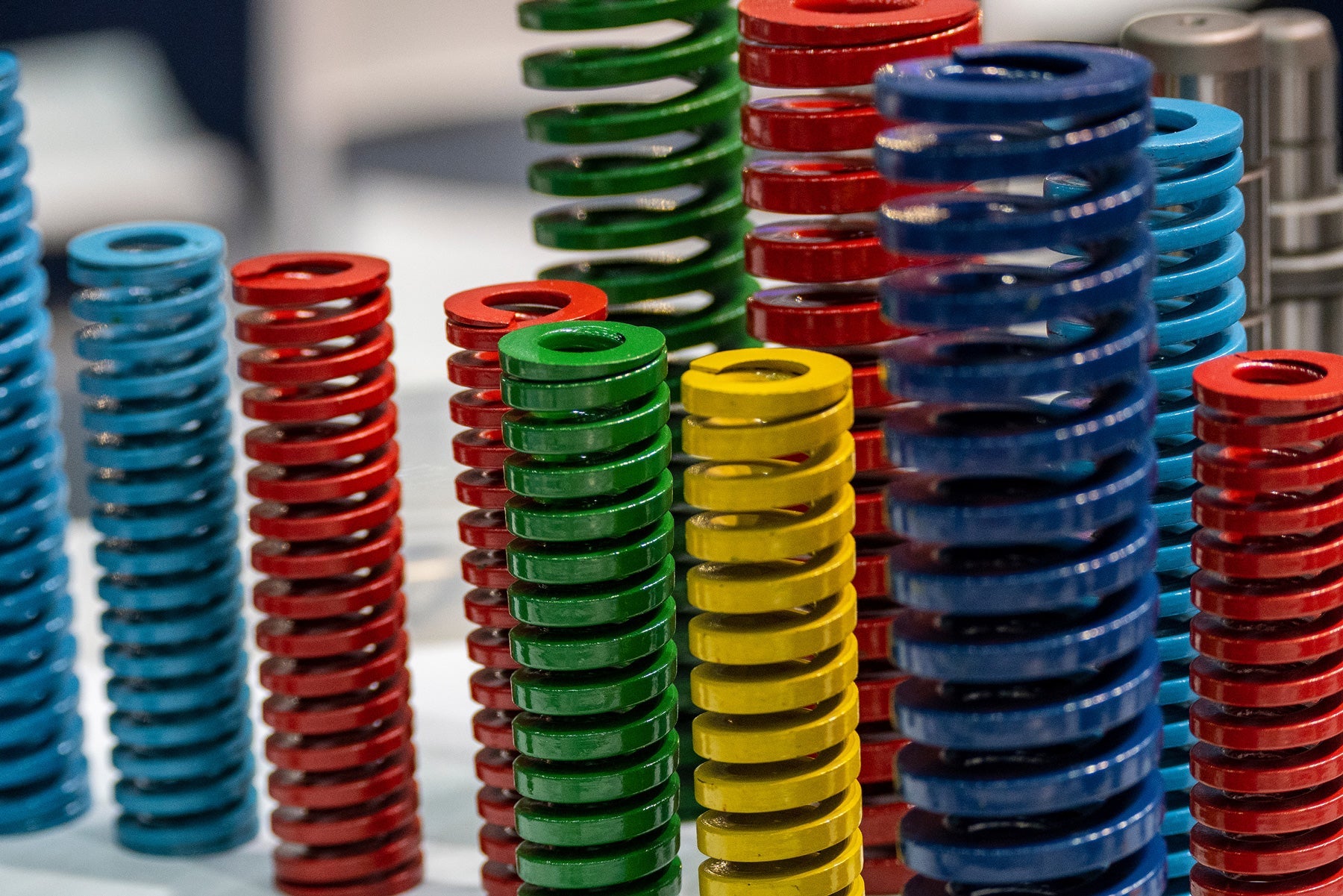
Die Springs: Everything You Need to Know About Their Construction, Materials and Performance Metrics
Die springs, commonly utilised with die sets, are a durable form of helical compression springs made from rectangular wire. These robust springs can handle high compression loads in harsh conditions and are often used in punch presses for consistent and dependable resistance. However, they can also be found in various other industries. The springs are crafted from rectangular wire with rounded corners and function similarly to standard compression springs, storing energy when under load in order to keep components separated. A tighter winding of the spring results in a higher spring rate, regardless of the wire used.
Die Spring Materials
Oil-tempered steel is often used for die springs, while chrome alloys are also frequently utilised. The addition of a chrome layer provides enhanced wear and corrosion resistance. Rarer but significantly stronger options include chrome silicon and chrome vanadium, which offer benefits such as improved dimension precision, reduced stress points, and suitability for higher temperatures. Additionally, these metals allow for the application of a coloured paint layer to indicate the spring's working load.
Die Spring Specifications:
Colour Coding
The colour-coding of Die Springs indicates their corresponding working load. However, it should be noted that there is no standardisation among manufacturers, so it would be best to consult a reference chart provided by the specific manufacturer. Different shades represent a range of light to extra heavy loads according to the manufacturer's specifications.
SpringXpert’s colour code for die springs consists of four different colours: yellow, red, blue, and green.
Yellow-coloured die springs indicate extra heavy load the highest load capacity or maximum strength. These springs are designed to withstand heavy loads and provide reliable performance in demanding applications.
Red-coloured die springs indicate heavy load they have a lower load capacity than yellow ones but still offer substantial strength.
Blue-coloured die springs fall into the medium-load range category. They provide a balanced combination of strength and flexibility suitable for many industrial applications.
Green-coloured die springs represent low-load capacities or light-duty applications where minimal force is required.
Die Spring Wind Direction
Die springs can be wound in a clockwise or counter-clockwise direction. As the load is applied laterally, the winding direction is typically not a significant factor.
Die Spring Ends
There are two main types of coil ends for die springs: closed and open-end.
Closed-end die spring
By decreasing the coil pitch of closed-end die springs, the wire end comes to rest on the neighbouring coil. As a result, the final coil of the spring becomes incomplete and loses its effectiveness, potentially causing a slight change in compression.
Open-end die spring
Open-end die springs lack pitch reduction at the wire termination point, which can result in an uneven surface if not ground. However, this may not be a significant concern for die machinery.
Die springs, whether open or closed-end, can be ground to form a flattened and stable load-bearing surface.
Die Spring Dimensions
The free length of a die spring is the measurement taken before any load or preload is applied.
The hole diameter refers to both the outer diameter and the overall width of the spring. This width will expand during compression.
The rod diameter refers to the inner diameter of a die spring, designed to fit onto the guide rod of die machinery.
The wire diameter refers to the size of the wire utilised in creating the coil.

Die Spring Performance
The elastic limit refers to the maximum level of compression that a die spring can withstand without becoming deformed.
Preload refers to the amount by which a spring's free length is reduced when under a consistent load.
The operating travel is the difference between the spring length before and after the application of the operating load.
The compressed length refers to the total length of the spring, once the preload and operating travel have been taken into consideration.
Solid height refers to the compressed length of a die spring, where each coil is in contact with the neighbouring coil under a load.
The spring rate of die springs is typically measured in newtons or kilograms and represents the amount of force required to compress the spring by a specified distance.
Die Spring Safety
The production of die springs is closely supervised to guarantee their quality when faced with high levels of stress. Therefore, it is important for consumers not to make any alterations to the springs. Exposure to corrosive materials such as lubricants and chemicals can lead to a shorter lifespan for the springs, as well as if the spring rods/guides become misaligned or are not properly managed. To keep the yield consistent, it is recommended that die springs be regularly cleaned and replaced in their entirety rather than individually within a set.
Die Spring Applications
Die springs got their name for being utilised in punch press die sets. These die sets are responsible for applying pressure to secure the material in place while the press punctures it. A lack of give from the die set could harm the punch, while excessive give would prevent perforation of the substrate. In some cases, die springs are also used in transportation and agricultural sectors.
